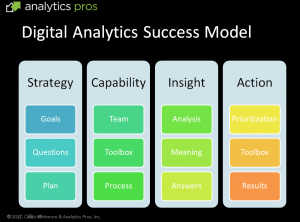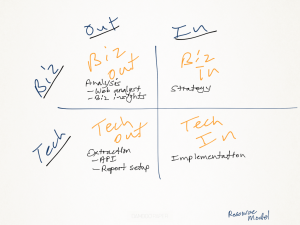Subscribe to our monthly newsletter to get the latest updates in your inbox
Three Buzzwords That Mean Something
Strategic. Digital. Analytics. Three buzzwords that on their own are over-used but, when strung together, actually mean something. I've been working in the www/.com/web/online/internet/interactive/web 2.0/digital/whatever-it's-called-next space for 13 years now, with the last 7 deeply focused on measurement and analytics of what we're (for now) calling "digital." When it comes to analytics and data, there is promise: that things can be made better. With data, you'll have insight. With insight you can improve things and gain an advantage in the marketplace. Yet, for all the data in the world, I daily see a surprisingly short-supply of this great promise actually becoming a reality within organizations. So, what to do about it? In working with hundreds of organizations across the world over more than a decade, from the smallest of small businesses to some of the largest and most widely known global brands, I've had the opportunity to face challenges that haven't been solved before and come up with (in collaboration with the great teams within client organizations and my own company) solutions for collecting, analyzing, and acting on data.Defining the Framework
What I'm excited to write about today is a framework I've refined from these years of experience in the digital space. It is a framework for a strategically driven approach to digital analytics that will help make good on the promise that data can make your organization more successful. This is the outcome of years of working with clients and distilling that experience into something defined and communicable. I debuted this framework first publicly on October 3rd 2012 at the GAUGE Conference in Boston.The Four Pillars
 Diving in, the framework consists of four pillars:
Diving in, the framework consists of four pillars:
- Strategy
- Capability
- Insight
- Action
The First Pillar: Strategy
The first pillar, Strategy, contains three components:- Goals
- Questions
- Plan
Goals
Goals addresses the critical issue of aligning your approach to digital analytics with your business and organizational goals. Out of the gate, I think most organizations are far from aligned when it comes to the data they have and the goals they are pursuing. Alignment of data with your goals means defining a strategy - a reason why - you have data in a way that relates to your organizational goals or mission. If your goal is to sell more widgets, then you need data that will help you sell more widgets. If your mission is to inform and educate your constituents, then you need data that can help you gauge if you are reaching your constituents if what you provide is indeed what they need, and if your digital platform is user friendly enough for them to use. [caption id="attachment_3913" align="alignnone" width="300"] Illustration of a mis-aligned business and an aligned one. The win is in getting them aligned[/caption]
Illustration of a mis-aligned business and an aligned one. The win is in getting them aligned[/caption]
Questions
Questions, or more precisely put, asking the right questions, is how we bring alignment into the picture. As it turns out, asking the right questions is the hardest part of this entire process. Why? Because figuring out the right questions is an intensely creative and highly time-consuming process. However, if you don't do this well, the rest of the process fails. [pullquote_right]Asking the right questions is the hardest part, it is intensely creative and highly time-consuming[/pullquote_right] Figuring out the "right" questions to ask can be done by beginning with your business goals. I developed a lifecycle model for digital analytics a couple years ago and wrote about it last year on this blog. This lifecycle illustrates the steps in the process of goal defining, question determination, data requirements, etc...Planning
Planning is a matter of developing a realistic roadmap and plan for turning the strategy into a reality. Did I mention realistic? That's absolutely critical. This is where most fail with Google Analytics for the fact that because GA is free, it creates the illusion that digital analytics is easy and instant. Yes, you'll have data but it's not useful data. As with any complex solution, Google Analytics must be installed properly and those using it must have appropriate training.Outcome of the Strategy Pillar
The outcome of the strategy pillar is that, as an organization, you will have defined a keen understanding of where you need to go; you'll have definition of what you need your data to provide you so it is aligned with your goals and/or mission; and you will have a credible plan with a realistic outlook to turn the strategy into a reality.The Second Pillar: Capability
[caption id="attachment_4001" align="alignright" width="300"] Team planning framework for Digital Analytics services[/caption] The best made plans, without action, won't turn into anything good. Building your digital analytics capability is often underestimated when it comes to a realistic outlook at what this will take in time and investment. In my framework, capability building follows the strategic planning process and is all about laying the foundation of team, technology, and process. To this end, I've developed a planning framework for evaluating your team's current capabilities against those which are essential for a functioning Digital Analytics capability. This framework is comprised of four areas:
Team planning framework for Digital Analytics services[/caption] The best made plans, without action, won't turn into anything good. Building your digital analytics capability is often underestimated when it comes to a realistic outlook at what this will take in time and investment. In my framework, capability building follows the strategic planning process and is all about laying the foundation of team, technology, and process. To this end, I've developed a planning framework for evaluating your team's current capabilities against those which are essential for a functioning Digital Analytics capability. This framework is comprised of four areas:
- Business Strategy - this area of expertise deals with the business side of data input, i.e. what data needs to be collected for what purposes, how will it be used, what questions will it answer, etc... Without proper attention to this area your digital analytics capability will invariably become mis-aligned with your business (see above).
- Technical data input - this field is technical and addresses the capability to implement an analytics solution in all its technical glory and mess. If you've ever undertaken a thorough implementation of SiteCatalyst or Google Analytics then you know just how complex this area can get. Don't under-estimate the required skillset in this area!
- Technical data output - this field delves into getting data out of your analytics platform. It typically involves writing custom reports, plugging into API's, and dealing with other aspects of handling extraction of data that are technical in nature. Note that this isn't your typical "web analyst" skillset (that's the next one) - it is closer to a software engineer/database administrator hybrid.
- Business data output - this skillset is all about analyzing data and making sense of it by tying it back to business objectives. It requires strong math skillset, data analysis capability, and communication and presentation prowess.
The Third Pillar: Insights
Insights is where the fun begins. This is where most people jump ahead to far too quickly. Up until this point efforts are not very "sexy" - but they're essential. The Insights pillar is about analysis of the data delivered by your new found capabilities built on the strong foundation of a good strategy. Analysis finds the nuggets of gold within the data, the key findings. Meaning though, that's the really important thing. Meaning is the connection between data and the analysis of it, and your business objectives and goals. If you can connect the dots between analysis of your data and your business, then you've got the ignition for finding meaning.The Fourth Pillar: Action
Action: this is what we're all after. Even with great meaning from analysis of our data, without action, it's pointless - and value-less too.Prioritization
The Action pillar begins with creating a hierarchy of priorities for the insights you've found. Let's face it: if you have a string digital analytics strategy and capability to match it, then you'll have plenty of insights. The challenge won't be having insights, it'll be acting on them, and overcoming that requires setting priorities. Creating priorities is simple: follow the value. Based on your insights and the meanings you find in them, list out actions and calculate conservative, moderate, and aggressive outcomes if you were to take those actions. Then, order the list of actions by potential value using whichever level of risk/reward you or your organization is most comfortable with. Voila: prioritized action.Toolbox
Simply having a prioritized list of action isn't the end, it's the beginning. To act, you need an additional toolbox ready to draw from. This toolbox should contain:- Tag Management technology (think Google Tag Manager as a starting point)
- Heatmapping / user experience analysis tools (CrazyEgg.com is my favorite)
- Voice-of-Customer tools (4Q Survey or UserReport are my favorite starting points)
- A/B/Multivariate Testing (right now, I can't recommend anything other than Optimizely!)
%20(1).png?width=2500&height=1667&name=Portal%20Drop%20Down%20(1)%20(1).png)